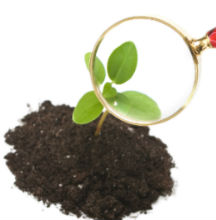Your landscape is one part of a large system involved with watersheds. Watersheds are large areas that drain into common lakes, rivers or oceans. Nature knows no property lines. A rainstorm or excessive irrigation can wash pesticides and fertilizers from your landscape and pollute your neighbor’s lawn and local waterways.
Keeping rain and sprinkler water on our yards—and out of storm drains—reduces pollution of our rivers, lakes and bays. Because water washes off our yards, it is important to reduce the amount of pollutants on our property. There are great benefits to having vegetated swales in your yard and using pervious surfaces for patios and walkways.
Rain gardens are landscaped depressions that intercept stormwater runoff and allow nature to remove some of the pollutants that would have otherwise affected water quality. They have become a popular and attractive method for property owners to decrease the impact of their impervious surfaces.
Harvesting rainwater in a barrel or cistern is a good way to reduce stormwater runoff and to save water for a dry spell. If you have gutters on your house, you may be able to collect 55 gallons of water during a 1/2-inch rain by connecting a downspout to a rain barrel or cistern.
Planting/maintaining a riparian buffer along a stream bank or pond (including a stormwater runoff pond) is beneficial to both soil and water. The vegetative buffer protects water resources from runoff that contains pollutants, such as sediment and pesticides, and provides bank stabilization along with aquatic and wildlife habitats.
The Virginia Conservation Assistance Program (VCAP) is an urban cost-share program that provides financial incentives and technical/educational assistance to Loudoun County homeowners and businesses who install Best Management Practices (BMP’s) in Virginia’s Chesapeake Bay Watershed to create more watershed-friendly landscapes. See Resources below for more information.
Maintaining a healthy pond will keep any overabundance of chemicals from flowing into nearby creeks, streams and water tables. The Loudoun Extension Master Gardeners have a Pond Assessment program that can assist you with proper maintenance of your pond. See program: Pond Assessments.
Spotlight: EPA Lawn Care Tips: Controlling water run-off:
My Backyard Measures
- Mow lawns to a height suggested for your specific lawn – usually 1/3 of the blade at a time, try not to scalp. Use the higher recommended height when the lawn is under stress, such as during times of drought and very high temperatures. Credit = 2 inches
- Sweep grass clippings, fertilizer and soil from driveways and streets back onto the lawn. Credit = 3 inches
- Remove trash from street gutters, so it will not get washed into storm drains. Never dispose of of anything down a storm drain. Credit = 2 inches
- Use mulch, permeable pavers, flagstone, gravel, or other porous surfaces for walkways, patios and drives. Credit = 2 inches
- Do your duty and pick up after pets. Properly dispose of waste in the trash. This will help reduce bacteria and nutrient pollution entering storm drain systems, ditches and local waterways. Credit = 2 inches
- Collect rainwater from your roof in a rain barrel or cistern. Credit = 2 inches
- Create a rain garden to catch, hold, and filter stormwater. Credit = 2 inches
- Where possible, direct downspouts and gutters to drain onto a well-drained area in the lawn or plant beds where rain will soak into the soil rather than run off the yard. Credit = 2 inches
- Protect your shoreline plants. Never prune or remove vegetation at the water’s edge without first seeking proper guidelines. Credit = 4 inches
- Install a buffer of native plants along your shoreline in line with the site characteristics and benefits expected from that buffer (nutrient removal, sediment control, streambank stabilization, etc.). Credit = 4 inches
- Schedule a site visit for erosion control or stream assessment, receive a report and follow best management practices. Credit = 5 inches
- Ensure a healthy pond. A pond mostly covered with overly exuberant vegetation is not only a nuisance to pond owners, but can also be detrimental to life in the pond and negatively affect the pond’s entire ecosystem. Contact us for a Pond Assessment, receive a report and utilize the Management Plan. Credit = 5 inches
Resources
- Know your watershed
- VCE Publication 426-046: Decreasing Runoff and Increasing Stormwater Infiltration
- Stormwater Management Fact Sheets: 6-part series on stormwater management for homeowners.
- Soak Up the Rain: Trees Help Reduce Runoff
- VCE Publication 426-722: Reducing Erosion and Runoff
- Loudoun County Stormwater Runoff Management Brochures
- Manage your septic system
- VCE Newsletter: Mow Like a Pro
- Forested Stream Buffers, Loudoun County
- University of MD Riparian Buffer Systems
- VCE Publication BSE-216NP: Stream Buffers Reduce Pollution Impact
- VCE Publication ANR-29: How to Plan and Plant Streamside Buffers
- Clemson: Stormwater Pond Management
- Loudoun Soil & Water Conservation District:



